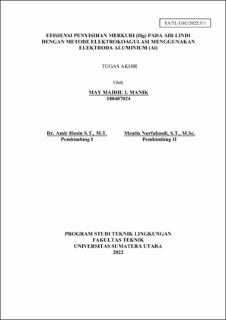| dc.description.abstract | One of the problems in the landfill is leachate treatment. Leachate is liquid waste that
comes from a combination of rain water, waste decomposition and surface water.
Mercury is one of the leachate parameter in the landfill. One of the treatment that can
be used to remove mercury is electrocoagulation. The research was conducted to treat
the effect of variations in electric voltage (4, 8, 12) volts, Contact time (15, 30, 45, 60)
Minutes and the distance between electrodes (1, 2) cm for 60 minutes on the efficiency
of removing mercury in leachate. After being analyzed, it was found that with a voltage
of 12 volt, 60 minutes times, and 1 cm inter electrode, the highest efficiency was
obtained at 99.32%. based on the results of ANOVA test, 86.1% of the variables used
had a simultan effect on the decrease of mercury. The data from the electrocoagulation
process were then analyzed to determine the appropriate adsorption kinetics and
adsorbtion isotherm. It has been obtained from the analysis that this electrocoagulation
process follows the pseudo second order adsorption kinetics model and the Freundlich
adsorbtion isotherm model. | en_US |

